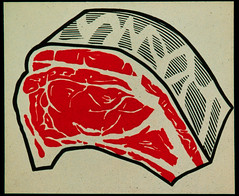June 7th
Blending Lambic
We’ve been meaning to blend up some more lambic for the past several weeks, but circumstances didn’t work out and things were delayed. We finally did get around to blending and bottling yesterday and it seems like a really good blend. It might be our best batch of Gueuze yet. Blending is incredibly difficult and I don’t think we’re master blenders, and we don’t try to create a consistent style from batch to batch. But we’ve seen that the final blend is always better than any of the single batch.
As a general rule, we try to create a blend that is roughly 25% three year, 50% two year old and 25% one year old. The older beers generally have considerably more character, but we’ve found that you need some young beer as well to give the final blend some freshness and more depth. The base beer is always 67% pils malt and 33% flaked wheat and we use a normal beer yeast for the first week or two, before we put the beer into carboys for aging. The blends of bugs are added to the carboys and we try to mix it up so that each carboy takes on a different character. The more variety in the base beer, the more possibilities in blending. Often we combine left over parts of older lots and consolidate them into gallon jugs or three gallons carboys. We’ve ended up with two jugs which have small portions of all of the first beers we made five years ago. As a general rule, we use half a gallon from each one, then combine them together and fill the other one with whatever is left over from our other older lots. The next time we blend, we’ll use half of each and then combine them again. It’s similar to a solera in that there’s always a portion of old beer in it.
Our normal blending batch is 8 gallons (based upon the size of our largest bottling bucket). We normally use one gallon of this old, solera style blend to add some backbone and complexity. This batch had the following lots blended into it:
1 Gallon of the Super Old “Solera Style” blend (average age about 4 years old)
1 .5 Gallons from a batch from March 2005
1 Gallon from a batch from February 2006
1 Gallon each from two different batches from December 2006
2.5-3 Gallons from a batch from November 2005
The “solera” blend was quite astounding on its own. The oldest lot was incredibly austere with moderate acidity and good length. It had a lot of peach and apricot flavors plus a good dose of horsiness. The March 2005 beer had more lemon/citrus flavors, more acidity, and a distinct smoky note. The February 2006 lot had a lot of pineapple and orange notes. It almost had a tropical fruit type of thing to it and it was considerably softer and less tart than the other batches. It would clearly add some interesting notes to the final blend, but it was my least favorite batch on it’s own. The two different lots from December 2006 were quite interesting. They had been stored indoors as opposed to in the garage. Although they both used different combinations of bugs, they were both incredibly tart and were the most acidic of all of the batches we tasted. Clearly the warmer temperatures from being aged indoors had favored the growth of the lactobacillus. They both had some smokiness as well and some lemon flavors. One of them had a distinct horsiness as well. They were as tart as anything form Cantillon and each sip made my eyelids quiver slightly (seriously). The final batch from November 2005 was interesting. It had the best overall aroma of any single lots. It had a great mix of horse, smoke, peach, citrus and apricot. On the palate, it seemed very sugary and candy-like. The palate and nose were completely different from each other. The final blend had a little bit of everything. It had good, noticeable acidity, and intriguing nose of citrus and stone fruits, smoke and horsiness. The palate had good depth and great length. The deep flavors of the older lots were nicely balanced by some of the younger, rounder, fruitier and sweeter lots. All this could change as it sits and develops in the bottle. I will likely try a bottle in about 2-3 weeks to see if the flavors are holding or if it’s changing. We’ve had some lots that change completely with six months of aging. We’re hoping this one keeps its general balance because it was so good at the time.
Sunday, June 8, 2008
Blending Lambic
Subscribe to:
Post Comments (Atom)

No comments:
Post a Comment